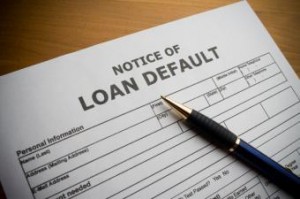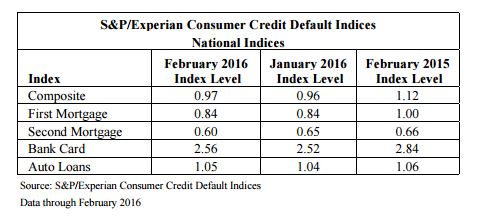 Recent positive economic news and rising consumer confidence helped keep consumer credit defaults at low levels, according to the February 2016 S&P/Experian Consumer Credit Default Indices (SPICE Indices) released on Tuesday.
Recent positive economic news and rising consumer confidence helped keep consumer credit defaults at low levels, according to the February 2016 S&P/Experian Consumer Credit Default Indices (SPICE Indices) released on Tuesday.
The composite default index, which consists of the first and second mortgage default rates, the auto loan default rate, and the bank card default rate, bumped up by one basis point from January to February from 0.96 percent to 0.97 percent.
The first mortgage rate remained unchanged for the second straight month in February at 0.84 percent. It was down over-the-year by 16 basis points (from 1.00 recorded in February 2015). The first mortgage rate appears to have stabilized after seeing three consecutive minor monthly increases in Q4.
The second mortgage rate, meanwhile, bumped up from 0.60 in January to 0.65 in February, but was down by one basis point over-the-year.
The default index rose month-over-month in only one of the five major cities covered in the report, Los Angeles (up four basis points to 0.76 percent).
 “Low and stable consumer credit default rates confirm the positive picture of the consumer economy seen in recent data on personal income and consumption,” said David M. Blitzer, Managing Director and Chairman of the Index Committee at S&P Dow Jones Indices. “Other positive indicators of the consumer economy include continued strong auto sales and rising home prices. Measures of consumer confidence and sentiment remain at high levels after slipping a bit in January and February. Consumer credit usage continues to expand, though January’s most recent data showed a somewhat slower pace than in the 2015 fourth quarter.”
“Low and stable consumer credit default rates confirm the positive picture of the consumer economy seen in recent data on personal income and consumption,” said David M. Blitzer, Managing Director and Chairman of the Index Committee at S&P Dow Jones Indices. “Other positive indicators of the consumer economy include continued strong auto sales and rising home prices. Measures of consumer confidence and sentiment remain at high levels after slipping a bit in January and February. Consumer credit usage continues to expand, though January’s most recent data showed a somewhat slower pace than in the 2015 fourth quarter.”
The Federal Open Market Committee (FOMC), the policy making body of the Federal Reserve, began its two-day March meeting on Tuesday with an announcement on the federal funds target rate forthcoming on Wednesday afternoon at 2 p.m. Eastern. The consensus among analysts is that the Fed will not raise the federal funds target rate in this meeting but that another increase will occur later in the year, possibly in the June FOMC meeting.
“While inflation is largely absent from current economic reports, the same strong job growth boosting consumer spending may be setting the stage for future price increases or further action from the Fed to raise the interest rate,” Blitzer said. “For now, low default rates and a strong consumer economy are in place.”

 DSNews The homepage of the servicing industry
DSNews The homepage of the servicing industry










